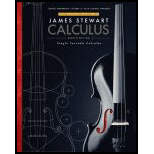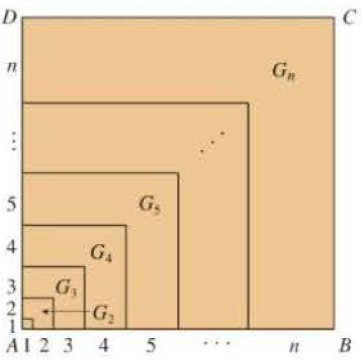
Student Solutions Manual, Chapters 1-11 for Stewart's Single Variable Calculus, 8th (James Stewart Calculus)
8th Edition
ISBN: 9781305271814
Author: James Stewart
Publisher: Cengage Learning
expand_more
expand_more
format_list_bulleted
Textbook Question
Chapter E, Problem 40E
Prove formula (e) of Theorem 3 using the following method published by Abu Bekr Mohammed ibn Alhusain Alkar-chi in about ad 1010. The figure shows a square ABCD in which sides AB and AD have been divided into segments of lengths 1, 2, 3, …, n. Thus the side of the square has length n(n + 1)/2 so the area is [n(n + 1)/2]2. But the area is also the sum of the areas of the n “gnomons” G1, G2, ..., Gn shown in the figure. Show that the area of Gi is i3 and conclude that formula (e) is true.

Expert Solution & Answer
Want to see the full answer?
Check out a sample textbook solution
Students have asked these similar questions
8. For x>_1, the continuous function g is decreasing and positive. A portion of the graph of g is shown above. For n>_1, the nth term of the series summation from n=1 to infinity a_n is defined by a_n=g(n). If intergral 1 to infinity g(x)dx converges to 8, which of the following could be true? A) summation n=1 to infinity a_n = 6. B) summation n=1 to infinity a_n =8. C) summation n=1 to infinity a_n = 10. D) summation n=1 to infinity a_n diverges.
PLEASE SHOW ME THE RIGHT ANSWER/SOLUTION
SHOW ME ALL THE NEDDED STEP
13: If the perimeter of a square is shrinking at a rate of 8 inches per second, find the rate at which its area is changing when its area is 25 square inches.
DO NOT GIVE THE WRONG ANSWER
SHOW ME ALL THE NEEDED STEPS
11: A rectangle has a base that is growing at a rate of 3 inches per second and a height that is shrinking at a rate of one inch per second. When the base is 12 inches and the height is 5 inches, at what rate is the area of the rectangle changing?
Chapter E Solutions
Student Solutions Manual, Chapters 1-11 for Stewart's Single Variable Calculus, 8th (James Stewart Calculus)
Ch. E - Prob. 1ECh. E - Prob. 2ECh. E - Write the sum in expanded form. 3. i=463iCh. E - Prob. 4ECh. E - Prob. 5ECh. E - Write the sum in expanded form. 6. k=58xkCh. E - Prob. 7ECh. E - Write the sum in expanded form. 8. j=nn+3j2Ch. E - Prob. 9ECh. E - Prob. 10E
Ch. E - Prob. 11ECh. E - Prob. 12ECh. E - Prob. 13ECh. E - Write the sum in sigma notation. 14....Ch. E - Prob. 15ECh. E - Prob. 16ECh. E - Prob. 17ECh. E - Prob. 18ECh. E - Prob. 19ECh. E - Prob. 20ECh. E - Prob. 21ECh. E - Prob. 22ECh. E - Prob. 23ECh. E - Prob. 24ECh. E - Prob. 25ECh. E - Prob. 26ECh. E - Prob. 27ECh. E - Prob. 28ECh. E - Prob. 29ECh. E - Prob. 30ECh. E - Prob. 31ECh. E - Prob. 32ECh. E - Find the value of the sum. 33. i=1n(i+1)(i+2)Ch. E - Prob. 34ECh. E - Prob. 35ECh. E - Find the number n such that i=1ni=78.Ch. E - Prob. 37ECh. E - Prove formula (e) of Theorem 3 using mathematical...Ch. E - Prove formula (e) of Theorem 3 using a method...Ch. E - Prove formula (e) of Theorem 3 using the following...Ch. E - Evaluate each telescoping sum. (a) i=1n[i4(i1)4]...Ch. E - Prove the generalized triangle inequality:...Ch. E - Find the limit. 43. limni=1n1n(in)2Ch. E - Prob. 44ECh. E - Prob. 45ECh. E - Prob. 46ECh. E - Prob. 47ECh. E - Prob. 48ECh. E - Prob. 49ECh. E - Prob. 50E
Knowledge Booster
Learn more about
Need a deep-dive on the concept behind this application? Look no further. Learn more about this topic, calculus and related others by exploring similar questions and additional content below.Similar questions
- please answer by showing all the dfalowing necessary step DO NOT GIVE ME THE WRONG ANSWER The sides of a cube of ice are melting at a rate of 1 inch per hour. When its volume is 64 cubic inches, at what rate is its volume changing?arrow_forwardSox & Sin (px) dx 0arrow_forward8 L 8 e ipx dxarrow_forward
- Find the Taylor polynomial T³(×) for the function f centered at the number a. f(x) = xe-2x a = 0 T3(x) =arrow_forwardFor each graph in Figure 16, determine whether f (1) is larger or smaller than the slope of the secant line between x = 1 and x = 1 + h for h > 0. Explain your reasoningarrow_forwardPoints z1 and z2 are shown on the graph.z1 is at (4 real,6 imaginary), z2 is at (-5 real, 2 imaginary)Part A: Identify the points in standard form and find the distance between them.Part B: Give the complex conjugate of z2 and explain how to find it geometrically.Part C: Find z2 − z1 geometrically and explain your steps.arrow_forward
- A polar curve is represented by the equation r1 = 7 + 4cos θ.Part A: What type of limaçon is this curve? Justify your answer using the constants in the equation.Part B: Is the curve symmetrical to the polar axis or the line θ = pi/2 Justify your answer algebraically.Part C: What are the two main differences between the graphs of r1 = 7 + 4cos θ and r2 = 4 + 4cos θ?arrow_forwardA curve, described by x2 + y2 + 8x = 0, has a point A at (−4, 4) on the curve.Part A: What are the polar coordinates of A? Give an exact answer.Part B: What is the polar form of the equation? What type of polar curve is this?Part C: What is the directed distance when Ø = 5pi/6 Give an exact answer.arrow_forwardNew folder 10. Find the area enclosed by the loop of the curve (1- t², t-t³)arrow_forward
- 1. Graph and find the corresponding Cartesian equation for: t X== y = t +1 2 te(-∞, ∞) 42,369 I APR 27 F5 3 MacBook Air stv A Aa T 4 DIIarrow_forwardMiddle School GP... Echo home (1) Addition and su... Google Docs Netflix Netflix New folder 9. Find the area enclosed by x = sin²t, y = cost and the y-axis.arrow_forward2. Graph and find the corresponding Cartesian equation for: (4 cos 0,9 sin 0) θ ε [0, 2π) 42,369 I APR 27 3 MacBook Air 2 tv A Aaarrow_forward
arrow_back_ios
SEE MORE QUESTIONS
arrow_forward_ios
Recommended textbooks for you
- Algebra & Trigonometry with Analytic GeometryAlgebraISBN:9781133382119Author:SwokowskiPublisher:Cengage

Algebra & Trigonometry with Analytic Geometry
Algebra
ISBN:9781133382119
Author:Swokowski
Publisher:Cengage
Maths - Geometry - What is an Angle - English; Author: Bodhaguru;https://www.youtube.com/watch?v=bsuDcCjFq6c;License: Standard YouTube License, CC-BY
What is an Angle? | Different Types of Angles | Geometry | Math | LetsTute; Author: Let'stute;https://www.youtube.com/watch?v=aGejx2fRCHU;License: Standard Youtube License